Please note: This article contains affiliate links to tools we use and love, and we may receive a commission if you click through and make a purchase.
Content marketing is vital for expanding your reach, building your brand identity, and increasing your revenue and sales.
In fact, 92% of marketers told Conductor that they see long-term content marketing strategy as positively impacting their organization’s marketing performance and goals.
But to succeed at content marketing, you must create and distribute effective content. And to create compelling content, you first have to develop engaging ideas for that content.
With a proven strategic approach — and help from forward-thinking content professionals like us here at The Blogsmith — you can learn to perform content ideation that aligns with your goals and target audience.
Content Ideation
Content ideation is the process you take when generating topics, or ideas to base your content on. It’s an essential part of the content-creation process.
There are various types of content marketing, and content can take many forms — from blog posts and landing pages to videos and interactives. This means the ideas for your content can also vary in nature, and the ideation process differs depending on your organization’s industry and priorities.
The Importance of Topic Ideation
Topic ideation is an undeniably crucial aspect of reaching success in content marketing, as every piece of content must have a topic. By doing it strategically and effectively, you’ll help yourself create the best content possible and enjoy benefits, such as:
- Establishing and bolstering your brand: Writing compelling pieces based on great topics enables you to build brand authority as you generate leads and improve upon critical metrics.
- Reaching a wider audience: Effective topic ideation helps you engage new readers, expand brand awareness, and maintain relevance over time.
- Fulfilling Google’s ranking requirements: To rank on search engine results pages (SERPs), you must regularly distribute helpful, reliable content that prioritizes the reader. And you can’t create this kind of content without first developing great ideas.
- Addressing diverse needs at different sales funnel stages more effectively: A strategic content ideation process allows you to better target buyers at various stages of the sales funnel — the step-by-step journey potential customers undergo before making a purchase.
The Challenges of Topic Ideation
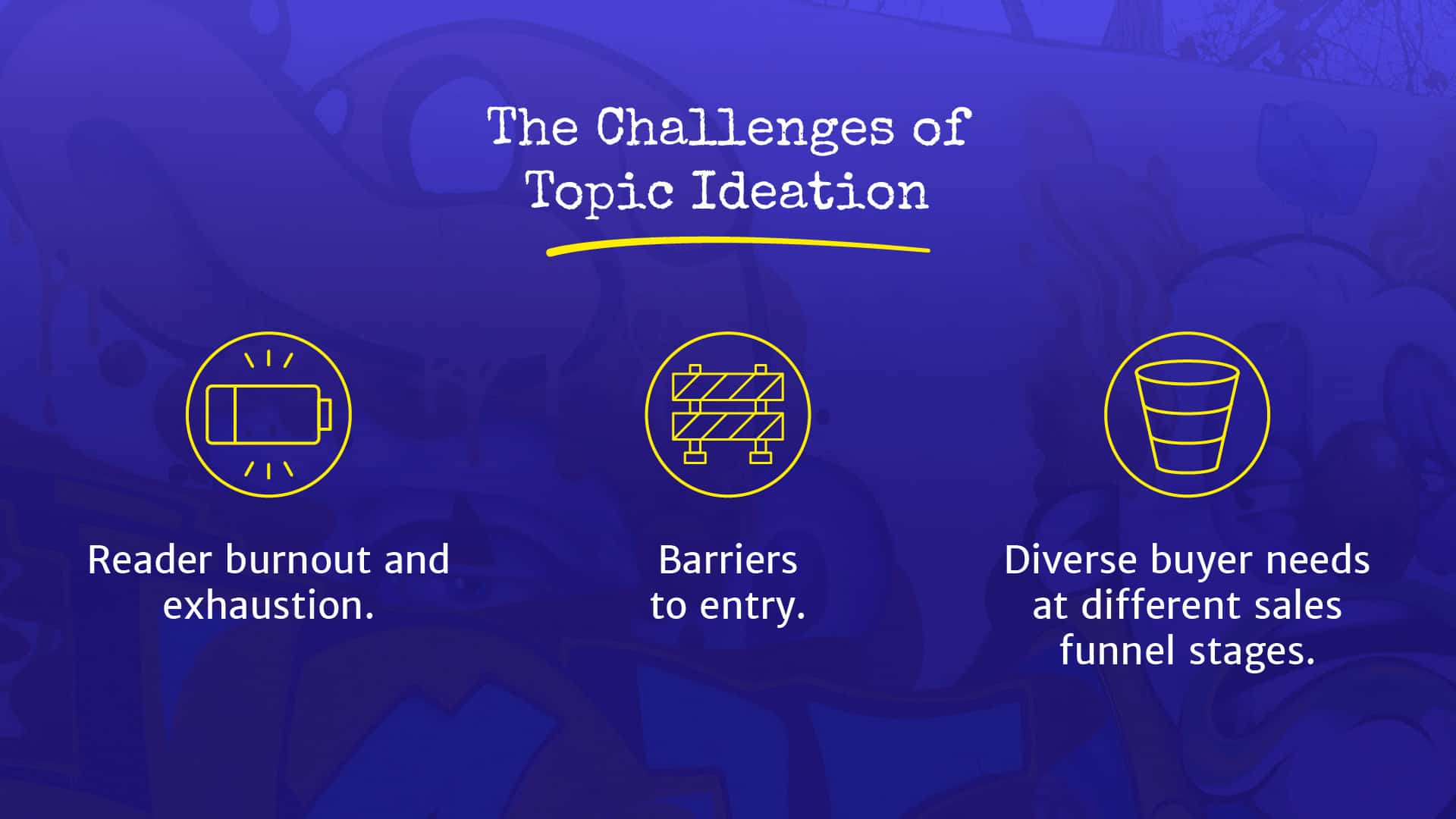
Don’t underestimate the positive impacts of great topic ideation! That said, there are plenty of obstacles to overcome to develop engaging, unique, and effective topics for your pieces, such as:
- Reader burnout and exhaustion: Modern internet readers can feel burned out and tired of sifting through content. Amid this contemporary digital landscape, it’s tough to come up with topics that pull readers in rather than making their eyes glaze over. Demand Gen’s research highlights this, revealing that over half of business-to-business (B2B) buyers are overwhelmed by how much content is available.
- Barriers to entry: Cutting through the noise — the seemingly infinite sea of subpar, boring, and repetitive content that doesn’t provide value — with great topics requires a strategic approach, an intimate familiarity with your audience, and overarching industry knowledge.
- Diverse buyer needs at different sales funnel stages: Creating content ideas that engage readers at different stages in the sales funnel requires alignment between a given topic, your brand’s objectives, and your target audience’s priorities at a certain point along the buyer’s journey.
If you’re willing to put in the necessary time and effort, you can certainly surpass these barriers to success and generate interesting topics.
But what exactly makes for a great content idea?
The Characteristics of Effective Topic Ideas
Effective content provides value to your readers, builds healthy relationships with your leads, and helps you achieve your goals. And effective topics are ideas that have the potential to develop into this kind of content.
Your topics serve as the foundation for your content, so they should be:
- Unique
- Informative
- Aligned with your brand
- identity and voice
- Relevant to your audience
- Tailored to your audience’s search intent
You’re probably itching to dig into the meat of this blog post … the “how to” of content ideation. So, let’s get started.
How To Generate Content Ideas
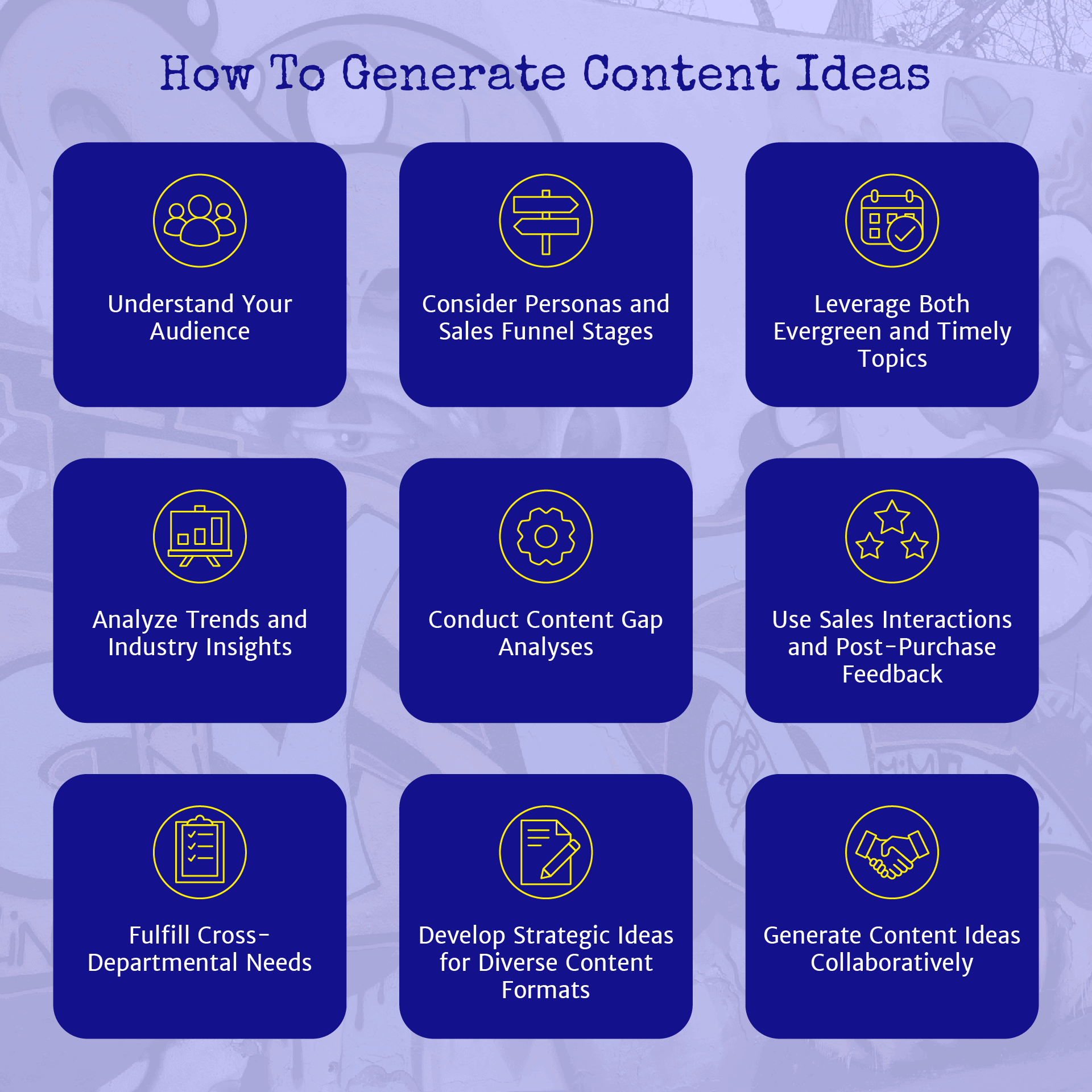
Coming up with compelling ideas to build your content upon takes a lot of effort. But you should work smarter — not harder — to ensure your efforts consistently produce the best results possible.
Here are a few techniques you can leverage to improve your content while making your life easier.
Understand Your Audience
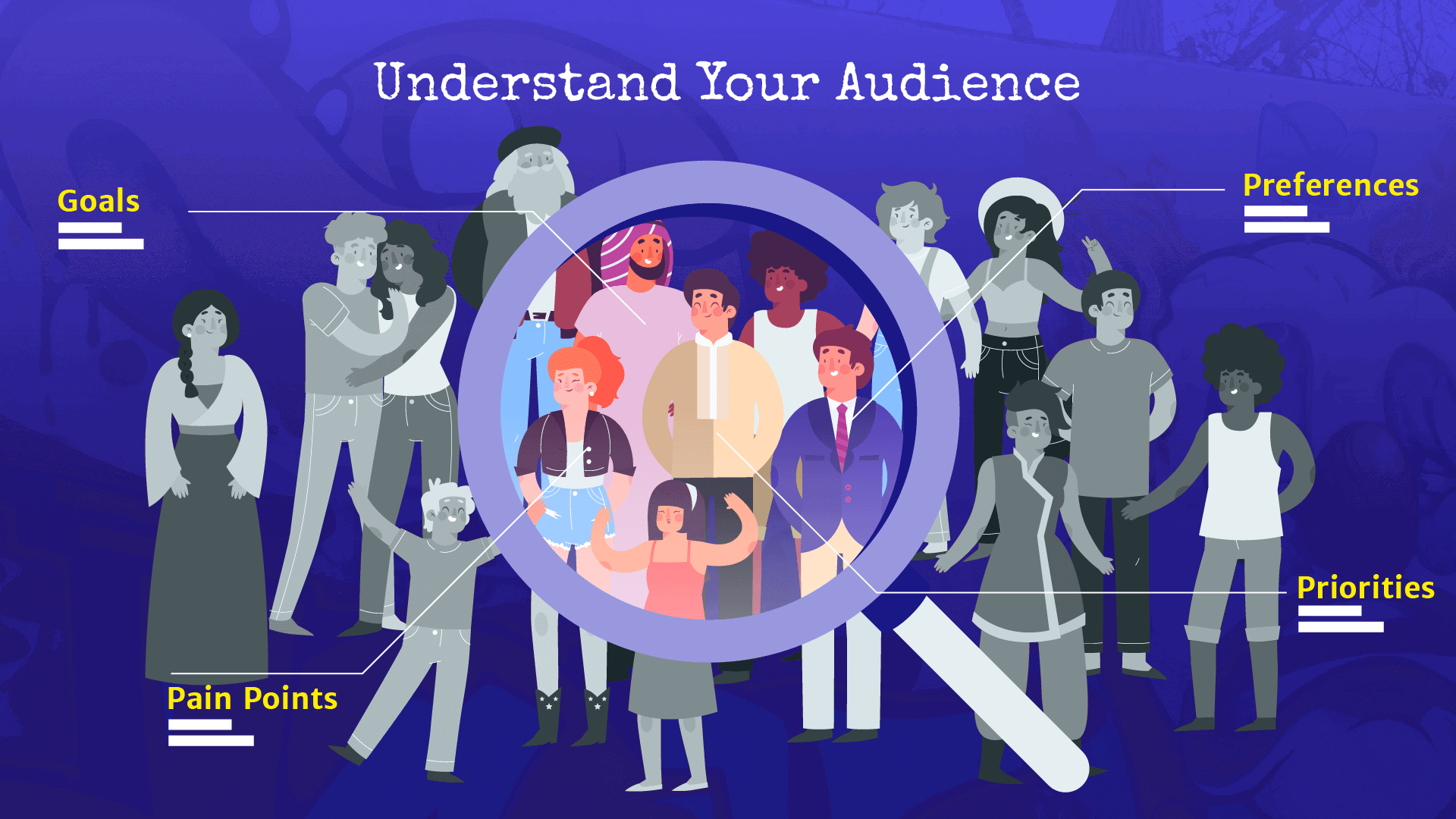
First and foremost, understanding your audience is nonnegotiable. This crucial focus provides essential insights to guide your topic ideation and content creation processes.
Without understanding your target audience’s goals, preferences, and primary motivations, how can you possibly know what they want to read about?
Without understanding your target audience’s goals, preferences, and primary motivations, how can you possibly know what they want to read about? Or which types of content will positively impact their behavior the most? How can you brainstorm ideas that help solve their pain points without knowing what those pain points are?
You can start to understand your audience by collecting relevant data and analyzing internal and external metrics — think engagement rates (like page views and social shares) or lead generation metrics (like email subscriber lists and conversion rates).
Using Google Analytics or another tracking and analytics system makes this process much more accessible.
Don’t skip this step — seriously! HubSpot’s 2022 research found that 82% of marketers say having high-quality data on their target audience is key to fulfilling their role successfully.
But shockingly, over 50% also say they’re missing vital information they need to understand their audience. This represents an opportunity for your business to rise above the competition. Take advantage of this reality and paint a clear picture of what your audience truly wants and needs.
Additionally, you’ll understand your audience better by using trial and error to determine how your readers respond to various types of content. Do this by measuring metrics before and after you distribute each piece, noting any trends you find over time.
Conducting general research via search engines to expand your knowledge of your competitors’ audiences, meeting and engaging with customers face-to-face, and continuously putting yourself in your readers’ shoes also help with this step. Other approaches that help you understand your audience include creating personas, soliciting feedback, and analyzing trends — but we’ll discuss those techniques in other sections.
Knowing what your readers need — and how your competitors are fulfilling (or failing to fulfill) those needs — is critical for identifying topics that provide value to your audience.
Consider Personas and Sales Funnel Stages
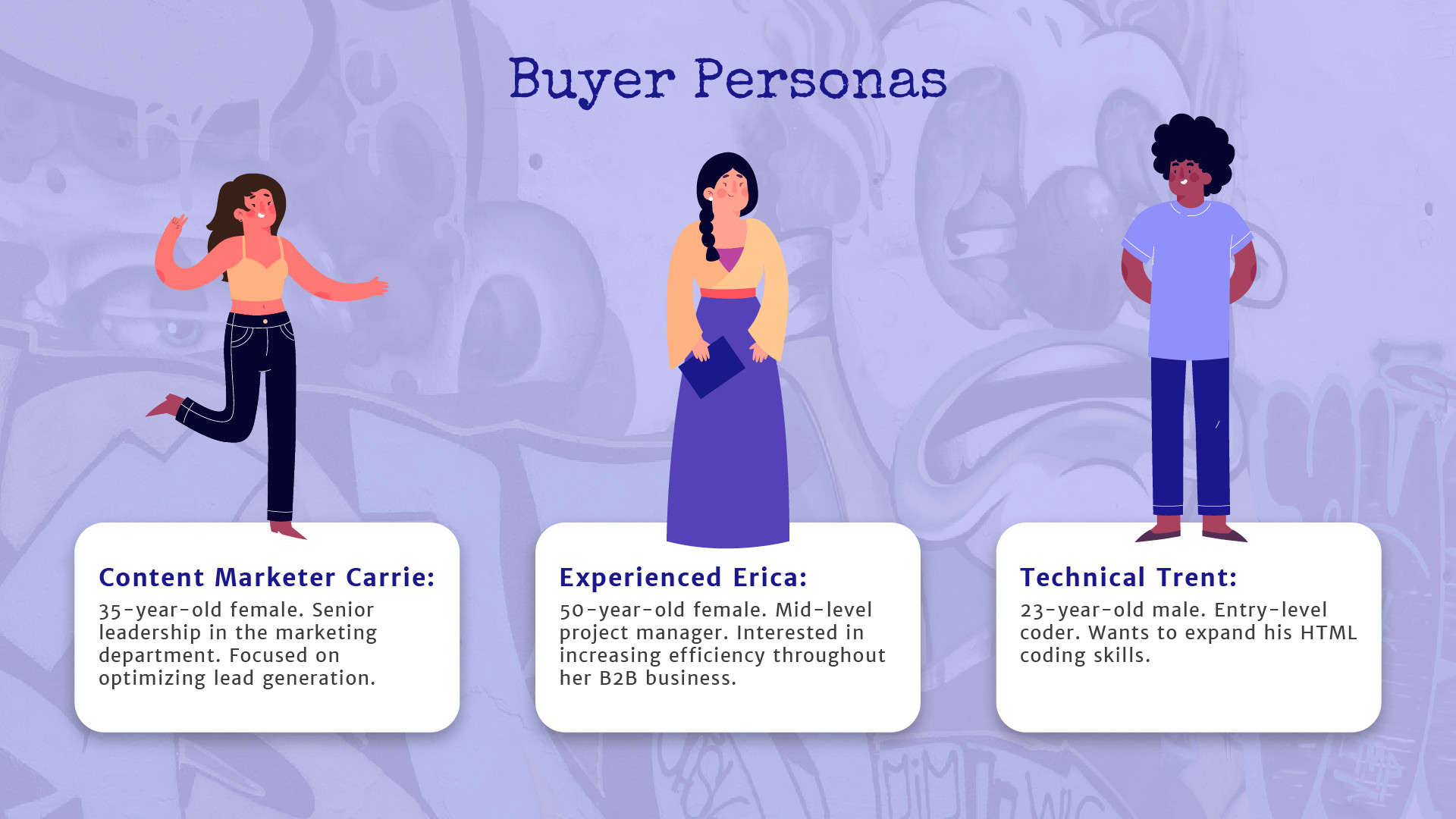
Does your organization have buyer personas — different versions of your target audience or ideal customer? What about a sales funnel framework to target leads at different stages in their buyer’s journey?
If you don’t leverage these, you’re not fully understanding your readers or getting the full scope of benefits from your content. You’re also making your content ideation process a lot harder.
This is because different leads respond well to various kinds of content. So, a lead who’s close to making a purchase isn’t looking for the same type of content as someone who’s just learning about a brand or product.
For example, if a lead was recently introduced to your product, they might want an informative video describing its benefits. But if they’ve been engaging with your content for a while and are super interested in purchasing your product, they may be influenced more by a webinar or free trial.
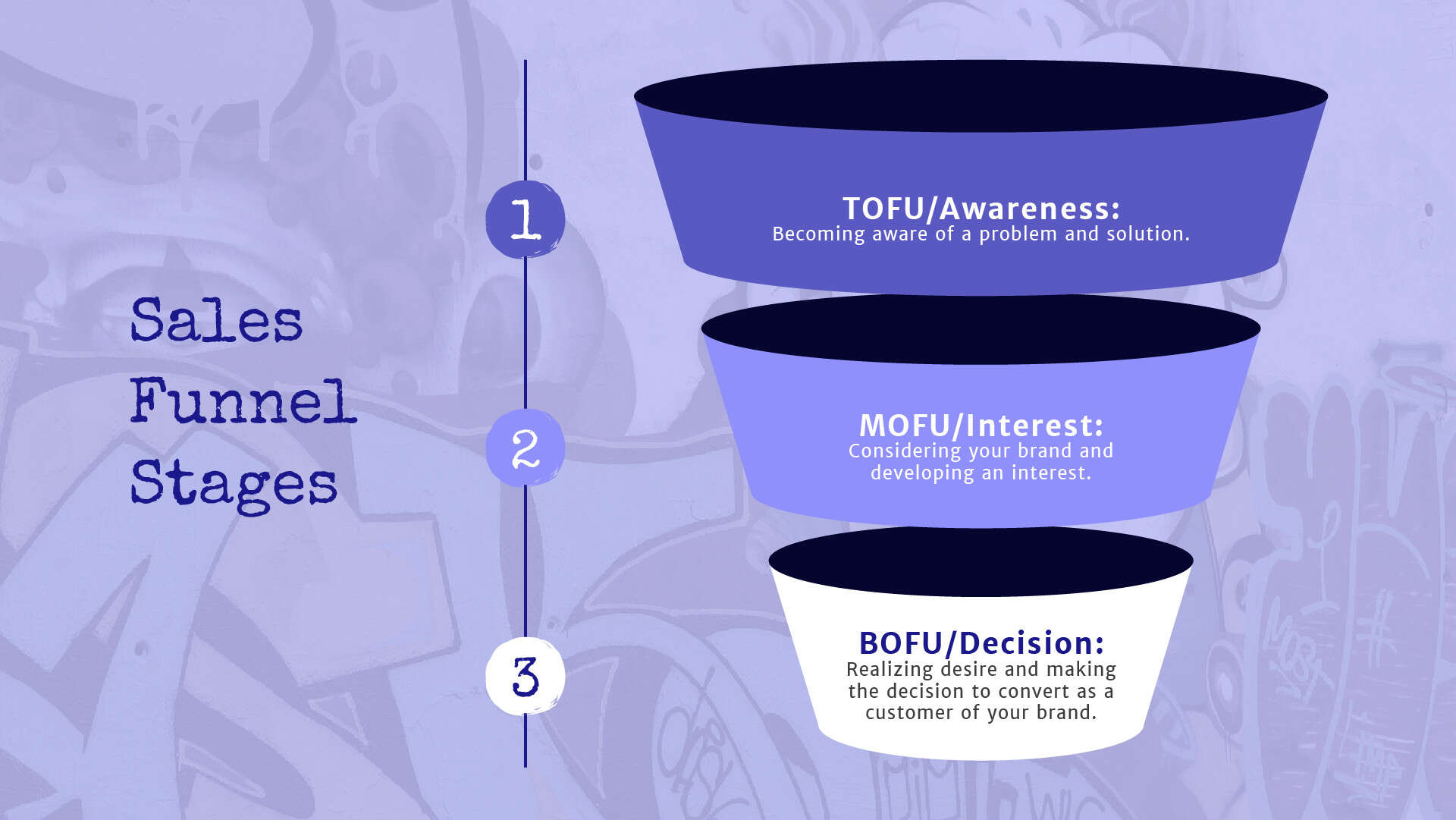
By considering different personas and stages, diverse kinds of topics will emerge naturally, and the ideas that arise will be better tailored to your audience’s primary needs at each unique point in the buyer’s journey.
This means your content strategy will have a better chance of fulfilling each reader’s expectations, hitting your audience’s pain points at the right time, and overarchingly helping your business find success.
Leverage Both Evergreen and Timely Topics
Taking a one-size-fits-all approach isn’t a recipe for success in topic ideation. With this in mind, you should balance both evergreen and timely topics.
Evergreen topics are relevant and valuable to the reader for the foreseeable future. Think how-to guides, case studies, or FAQ lists. One example from our blog is “Who Needs a Style Guide? Why Your Business Needs One.”
On the other hand, timely topics are tied to a specific current trend, time of year, or event. Think press releases about new product launches, seasonally centered blog posts, or brand updates. One example from our blog is an article announcing The Blogsmith Founder Maddy Osman’s book, “Writing for Humans and Robots.”
By consistently providing a healthy mix of both, you can provide long-term value to your audience while maintaining relevance.
At The Blogsmith, we regularly write articles about evergreen topics, such as best practices for writing content, strategies for engaging with your readers, and our internal processes.
But we also touch on time-sensitive topics and always keep our readers up to date with industry changes. Examples include important algorithm and software updates (like Google’s Helpful Content Update), optimal SEO tactics for the current moment, and new tool reviews.
Analyze Trends and Industry Insights

Conduct market, keyword, and trend-related research. This allows you to deepen your industry knowledge, comprehend your overarching context, and keep your finger on the pulse.
For example, if you know that podcast ad revenues in the U.S. are projected to more than double from 2022-2025, you might be motivated to try leveraging this format. And that move could help you reach a whole new market segment.
Staying informed helps you generate more relevant and valuable content topics and, as a result, affords you the ability to drive the conversation surrounding those topics. This, in turn, gives you opportunities to create thought leadership, showcase your industry expertise, and achieve more with your overall marketing efforts.
There is an array of research and tracking and analytics tools that make this easier. Paid solutions like BuzzSumo and Awario provide more robust capabilities, but Google Analytics is a great free alternative.
Here at The Blogsmith, we’re laser-focused on B2B and software-as-a-service (SaaS) industry news. This is our lane, our niche, our area of expertise. Our dedication to knowing what’s up in this market empowers us to create new content ideas that are forward thinking, timely, and targeted exactly to readers’ needs.
Conduct Content Gap Analyses
Have you heard of a content gap analysis? If not, it’s probably because this process is tragically underused.
During a content gap analysis, you evaluate existing content about a certain topic to identify “gaps” — missed opportunities. This helps you easily find subtopic ideas not featured in competitor content, identify keywords to rank for, and develop ideas for relevant yet largely unaddressed topics.
You should do this with your own content and also with your competitors’ pieces. Competitive analyses reveal new possibilities for connecting with your audience and building your business. Evaluate not only blog posts and articles but also potentially overlooked content, such as landing pages.
There are tons of competitor analysis tools that make this process easier.
Google Analytics offers instant data-driven insights on the competition. Semrush has monitoring features that track your competition’s SEO, market, and brand performance. BuzzSumo’s Competitor Intelligence tool shows you which pieces of competitor content are performing best and can even send you alerts about your top competitors.
All of these tools provide information, metrics, and helpful details about your competitors and the current state of your industry. And these deep insights can help you reveal potential content gaps you may not have noticed otherwise.
Use Sales Interactions and Post-Purchase Feedback
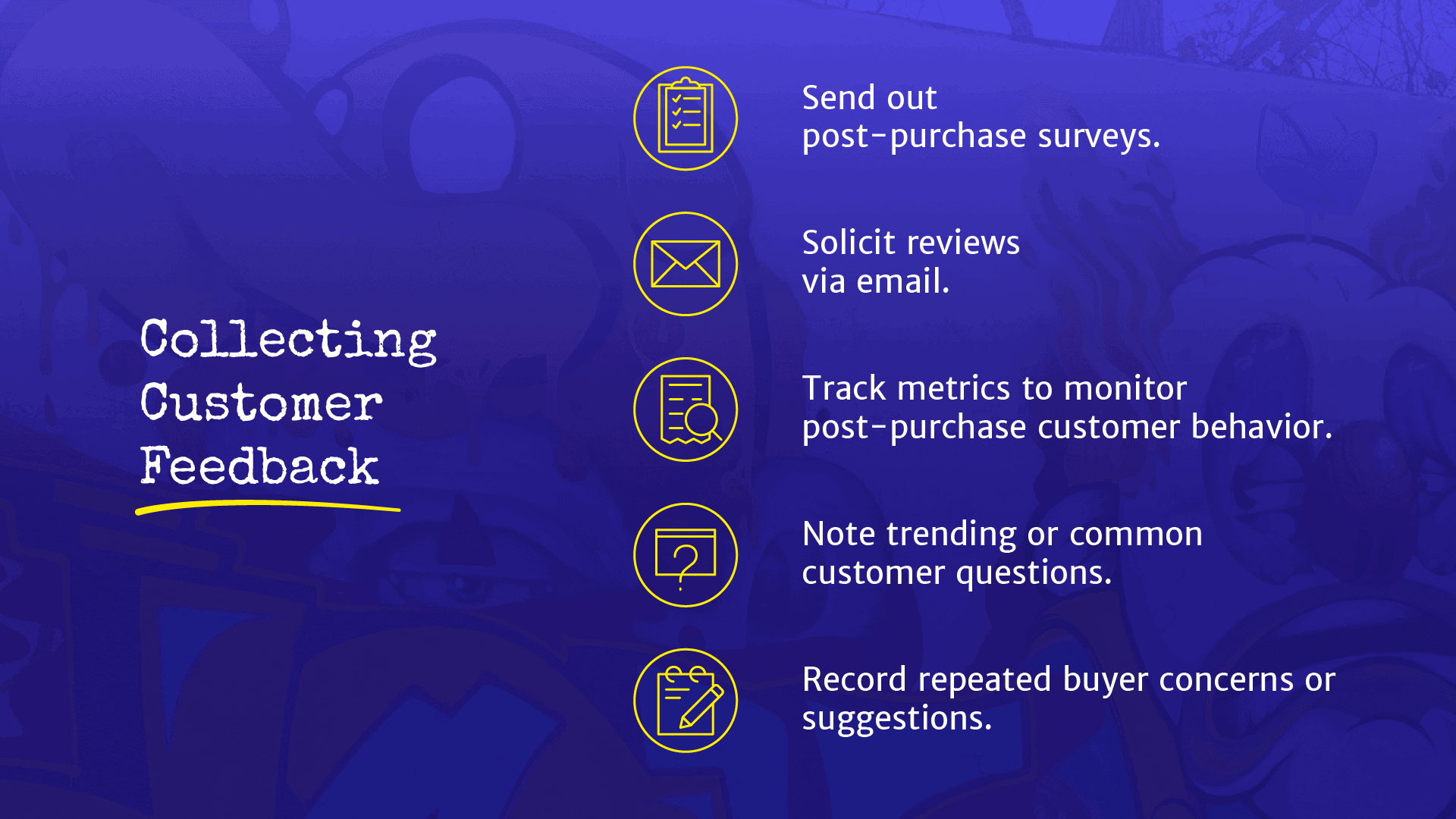
Practice makes perfect, right? We learn from our mistakes and failures, fine-tuning our approaches and improving our results over time.
By analyzing past sales interactions and post-purchase feedback — which requires some cross-functional collaboration between your sales, customer service, and marketing teams — you can glean undeniably relevant and valuable content topics.
You can do this by sending out surveys, asking for reviews, and monitoring how customers behave after making a purchase. We recommend using email to solicit feedback since it’s the most effective method for requesting reviews.
Keep an eye on trending or common questions, concerns, and suggestions amid reviews and surveys. Take note of any patterns in customer feedback, and use all the insights you gain to inform your content ideation process.
For example, if you find that customers are consistently asking a specific question after purchasing, you could turn that inquiry into a blog topic. Alternatively, you could answer the question on your website’s FAQ page or in your post-purchase confirmation email.
We always start a new client engagement by gathering topic ideas from common customer questions and contact form submissions. We do this because we know that these ideas are extremely relevant to our clients’ target audience and can provide valuable information, satisfy customers, and establish brand authority.
Fulfill Cross-Departmental Needs
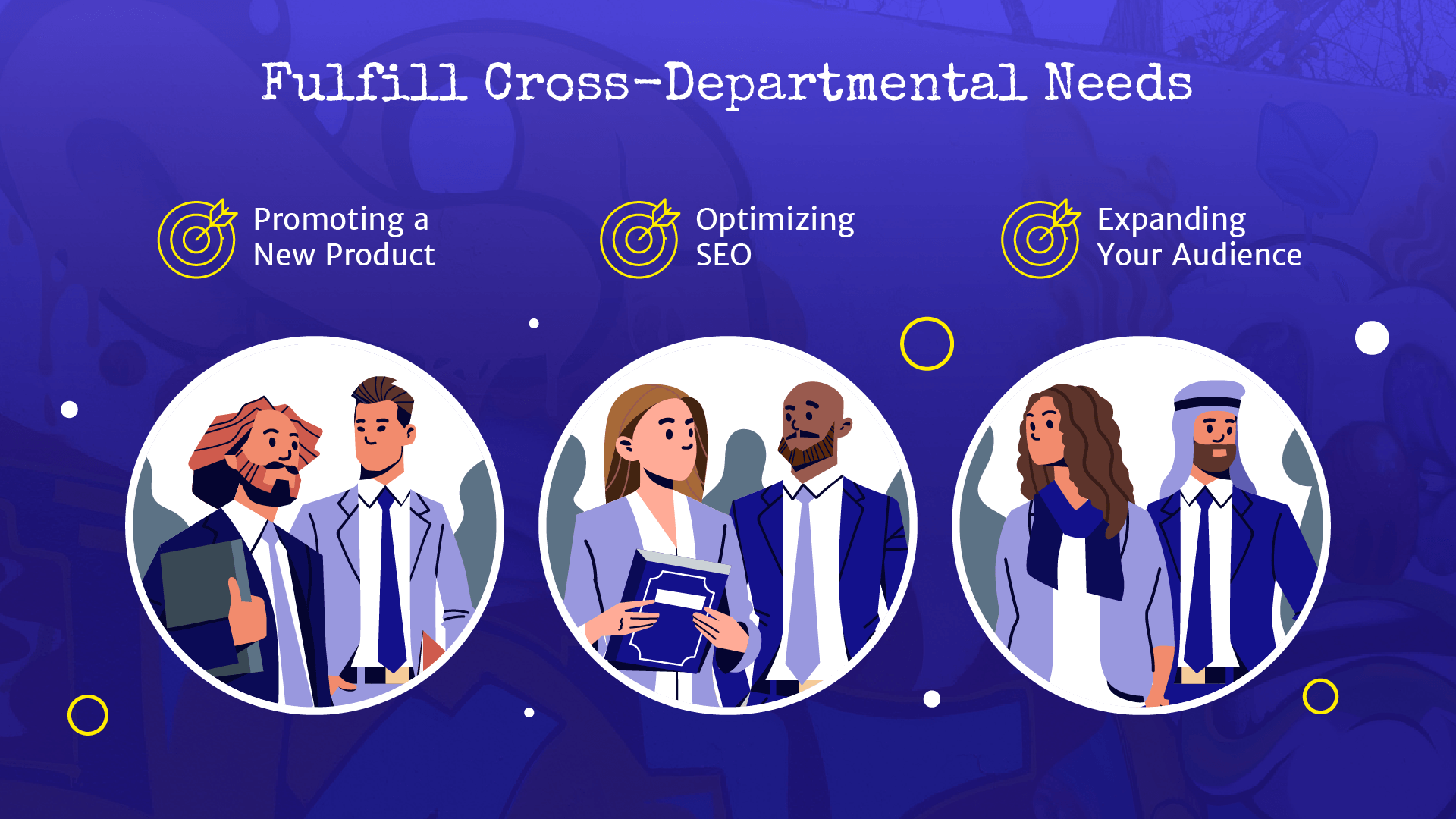
When brainstorming topics, a multifaceted approach is vital. One team within an organization may prioritize improving upon specific metrics, while others may be focused on promoting particular products or featuring a specific type of call to action (CTA).
To get an idea of what various departments need, you can conduct one-on-one meetings with department heads, send out in-house surveys, and have collaborative feedback sessions. Your content agency might also connect with different internal teams, so the subject matter experts (SMEs) in each department can offer insights on cross-functional priorities.
Once you pinpoint these interdisciplinary needs, you can start fulfilling them.
But to effectively address those needs, you’ll need to be creative and adaptable with your content ideation. So, when coming up with topic ideas, don’t get too stuck on a single aim or perspective. Instead, think holistically and look outside of the box.
So, when coming up with topic ideas, don’t get too stuck on a single aim or perspective. Instead, think holistically and look outside of the box.
Leveraging connected ideas for topic clusters — groups of content assets featuring related topics and subtopics — makes this easier. This is because when you think about related topics, new ideas start to emerge and branch off naturally.
At The Blogsmith, our clients have diverse departmental needs. So, rather than fixating on topic ideation for just a client’s marketing team, we consistently consider what each team within that organization would benefit from.
And we use those considerations to develop engaging ideas that effectively target a range of interdisciplinary needs.
Develop Strategic Ideas for Diverse Content Formats
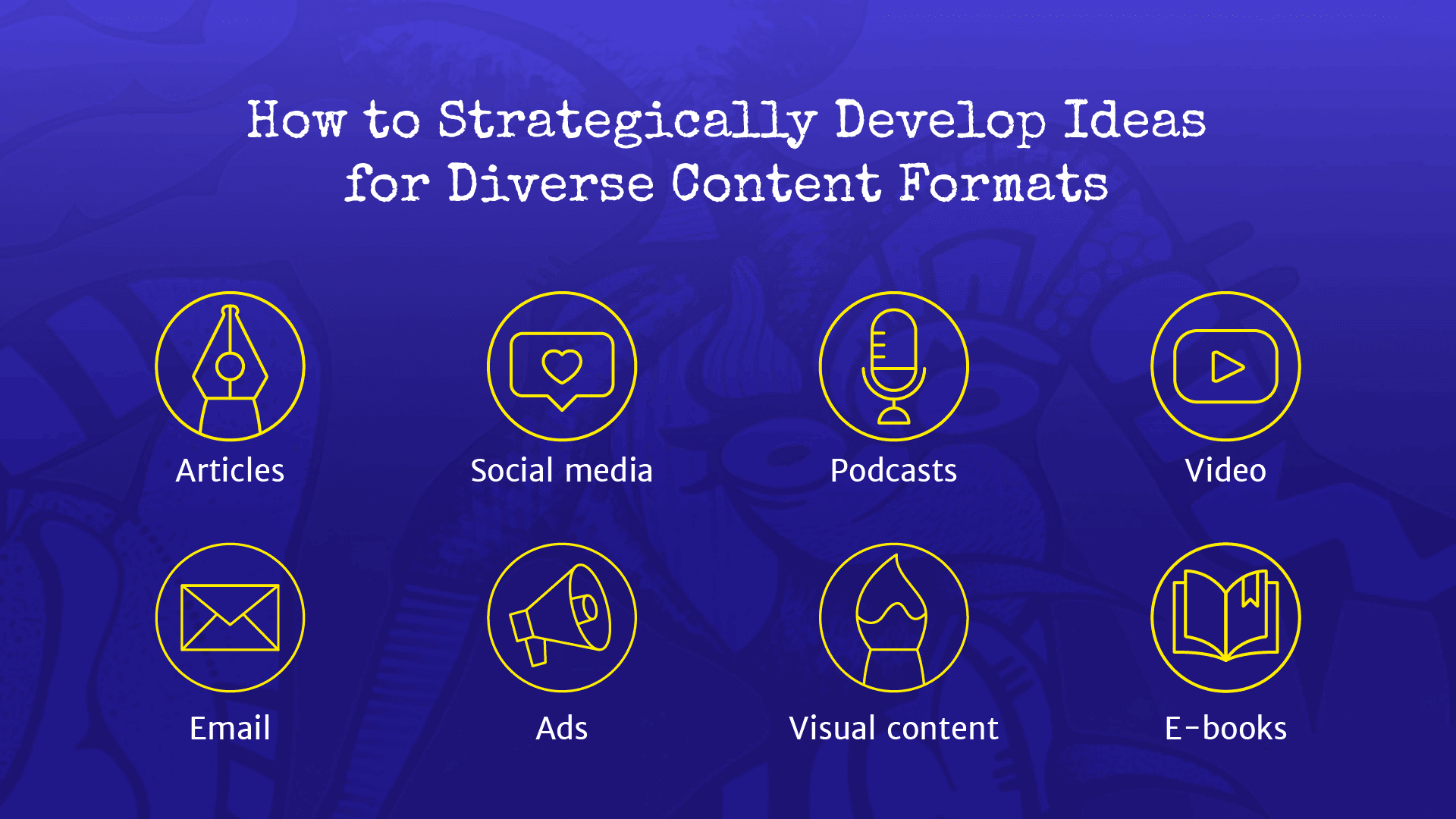
To create the most compelling, high-quality content, you’ll need to come up with ideas for a range of content formats. This is because each media format comes with unique opportunities, benefits, challenges, and characteristics.
Semrush’s 2023 State of Content Marketing Report revealed that the five best-performing content formats are video, short-form articles, success stories, long-form blog posts, and case studies.
Other popular formats you can use include email surveys, white papers, interviews, infographics, web copy, and e-books.
By strategically pairing ideas with effective formats by considering the strengths of each content type, current client goals, and the nature of the topic, you can make the most of our content ideas, provide more value to readers, and consistently surpass client expectations.
To develop the best ideas for each format, refer to all of your insights and research. Leverage that information, use common sense, and keep your goals in mind when determining how to manifest your ideas effectively.
For example, imagine that you have a great “how-to” topic idea, your target audience is backend developers, and you’re aiming to bolster brand authority. You might opt for technical, long-form knowledge-base articles with actionable resources.
But what if your content idea is more fun and you’re working to develop brand identity rather than authority? Then short-form video content on social media would likely be more effective.
Generate Content Ideas Collaboratively
Have you ever heard the slightly cringe saying, “teamwork makes the dream work”? When it comes to content ideation, it’s undeniably true!
Brainstorming with team members, industry peers, and organizational leaders is a great way to incorporate a wide range of perspectives. This strategy makes for more interesting, original, and comprehensive content ideas.
Make sure to encourage constructive criticism and honesty in all brainstorming sessions. McKinsey found groups who were encouraged to critique ideas during sessions generated 16% more ideas than teams who were told the opposite.
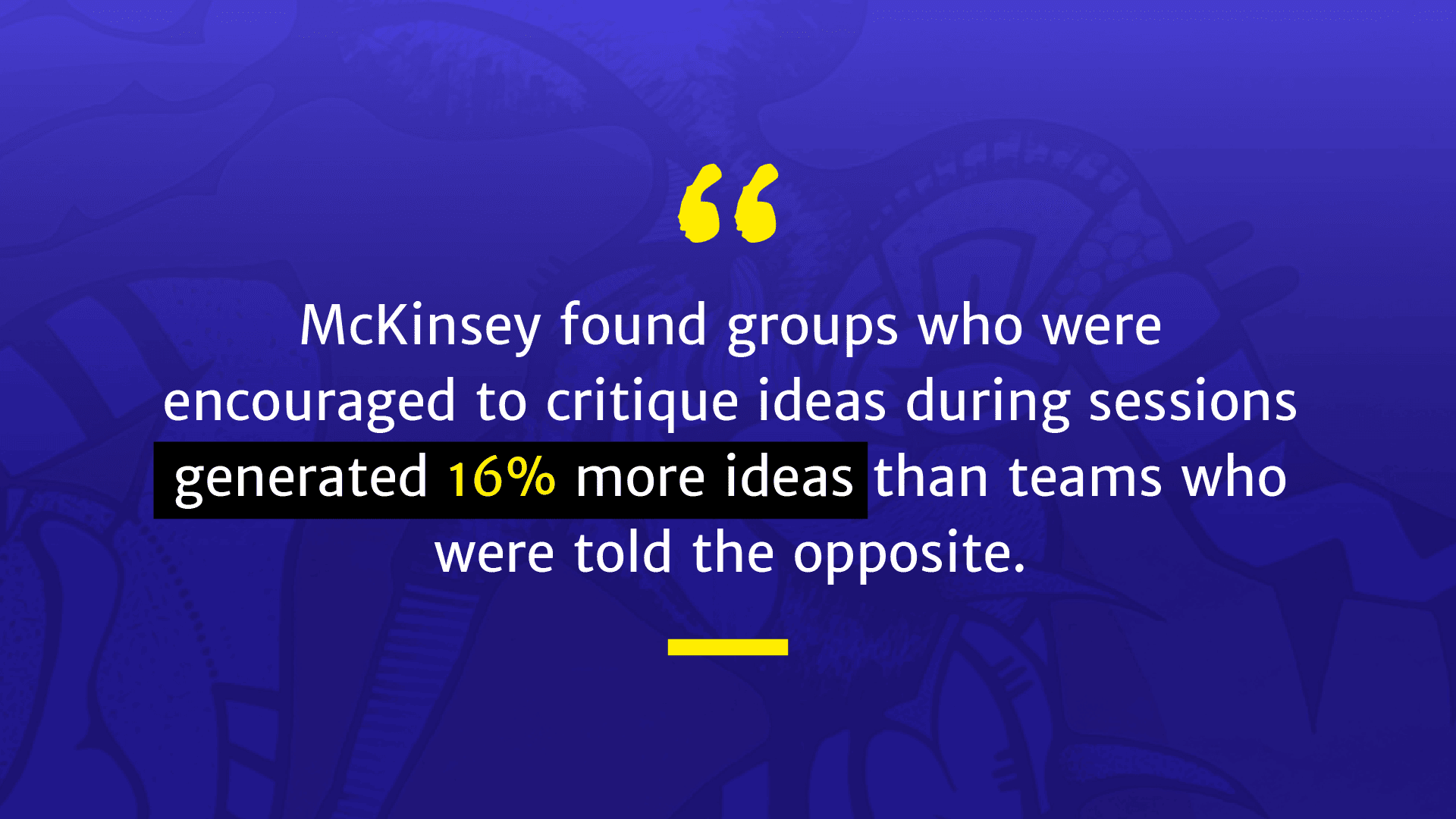
If your team doesn’t work together in person, you can use tools like online forums and digital meeting platforms to do this.
We collaborate extensively when coming up with potential topics at The Blogsmith. This ensures we fully understand what we need to cover and can approach each piece of content with the most informed perspective possible. As a result, we develop not just more ideas but better ideas.
Effective Content Ideation Tools
Here are a few of The Blogsmith’s favorite tools to use when brainstorming topics:
Frase
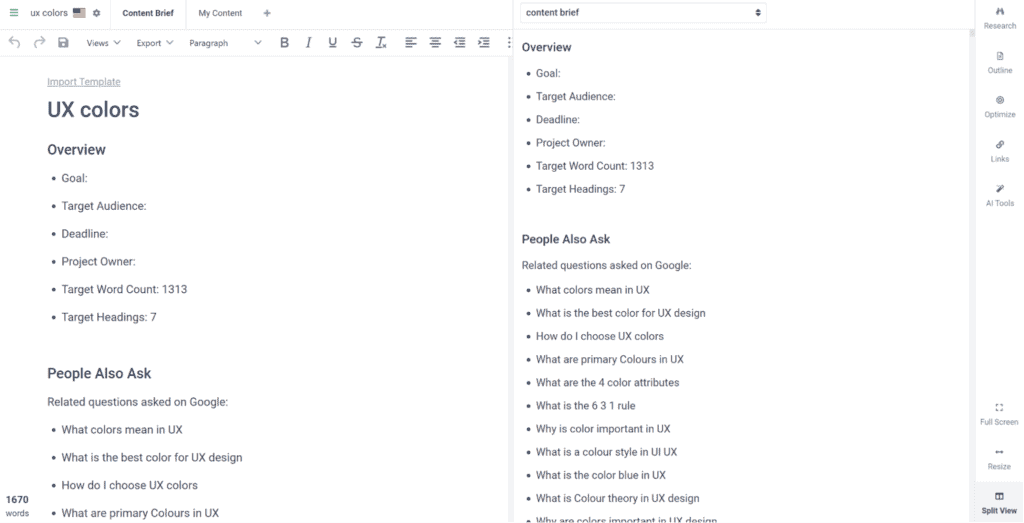
Frase is an AI-powered content briefing and optimization tool. It helps you brainstorm through features and functionalities, like concept maps, suggested topics and topic clusters, and question ideas.
You can leverage Frase to get inspiration for general topics, select the best ideas for subsections or subtopics, and determine an idea’s potential effectiveness based on keywords and existing content. Once you have your ideas, you can also use it to create great content briefs and outlines, helping you optimize your content across the board.
MarketMuse
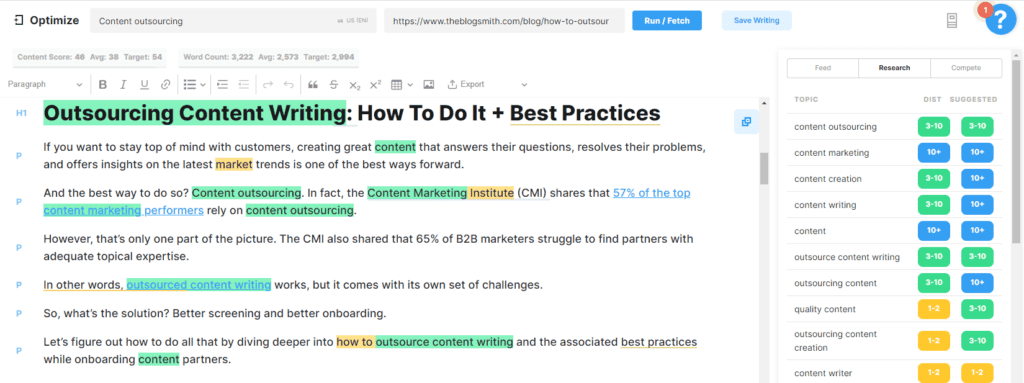
MarketMuse is a data-driven software that you can use to create briefs and improve your content. Using its related terms features is a great way to come up with topic cluster ideas.
While this tool has many features, the Subheadings Topic Modeling functionality is especially useful. Once you create a brief and select subheadings, you’ll automatically get information associated with each subheading.
This info comes in three categories: Questions To Answer, Topics To Mention, and Links. Thanks to this element, it’s much easier to fulfill reader needs and decide how to organize your subtopics.
Clearscope
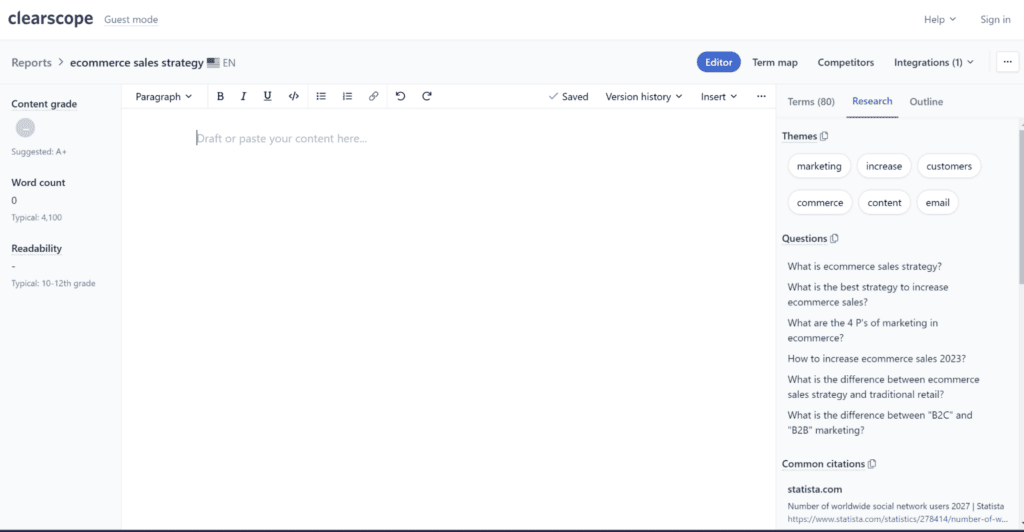
Clearscope, like the two tools above, is an automated digital framework designed for enhancing your content according to SEO best practices. It instantly provides suggestions for keywords and insights on search intent, making content ideation much easier.
Its optimization tools are incredibly helpful for improving your drafts once you’ve written them. Even beginners can create a report with ease.
Although Clearscope shines the most brightly when it comes to post-writing tools, it also presents utilitarian prewriting functionalities that help with topic ideation. Each Clearscope report offers insights in three categories: Terms, Research, and Outline.
These tabs contain suggestions for reader questions, potential sources, headings, and phrase suggestions. As a result, each report provides instant inspiration for topics that are relevant and valuable to readers.
Final Thoughts: Content Ideation — How To Generate Engaging Topic Ideas
Generating engaging content ideas is a huge challenge in today’s content marketing landscape — which is littered with bad content and burned-out readers. But by using the above strategies, you can improve your content ideation process and develop ideas that truly hit the mark.
Are you looking for more help coming up with engaging ideas for your digital marketing content? Or perhaps you’re interested in optimizing your overarching content marketing strategy.
Here at The Blogsmith, our comprehensive SEO and content marketing services include everything from topic development to keyword research to supportive imagery sourcing and creation.
Contact The Blogsmith for help creating engaging content ideas that make your business shine.












